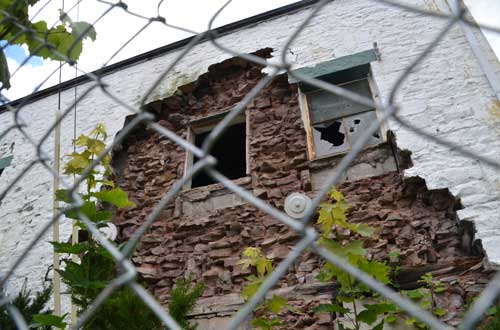EPA will discuss next phase of Diaz cleanup at July 11 meeting

File photo by Tom Rivers: The federal Environmental Protection Agency has taken down many of the buildings from the former Diaz Chemical in Holley. Now the agency is focused on removing the soil of contaminants. The EPA will discuss its soil remediation plan from 5 to 7 p.m. on July 11 at the American Legion, 5 Wright St.
HOLLEY – The federal Environmental Protection Agency is ready for the next phase of its cleanup of the former Diaz Chemical, which is a Superfund site.
The agency has removed Diaz buildings, drums and pipes with chemicals, and other above-ground contaminants. Only a Diaz warehouse remains from when the company operated until declaring bankruptcy in 2003.
The agency last year relocated 1,200 feet of a 12-inch waterline on Jackson Street and South Main Street.
This year, the EPA will focus on contaminated soils. The EPA will discuss its plan from 5 to 7 p.m. on July 11 at the American Legion, 5 Wright St. EPA staff will be there to take questions from the community and discuss the remediation plan.
The next phase of the cleanup will involve in-situ thermal treatment (ISTT) of contaminated soils and groundwater in on-site source areas, continued operation of vapor mitigation systems in three nearby residential properties and monitoring of the groundwater outside the source areas, according to an announcement from the EPA.
The ISTT system consists of a network of wells that deliver heat into discrete subsurface unsaturated and saturated areas of soil. Co-located with the heater wells is a system of extraction wells and temperature/pressure monitoring points.
The treatment area will be covered with an insulated cap to ensure a tight vapor seal which aids in heating and vapor recovery, and prevents both heat losses to the atmosphere and precipitation infiltration.
The application of heat to the subsurface results in the conversion of organic chemicals into the vapor or gas phase, where they are removed under vacuum by the extraction wells, the EPA said.
The extracted vapors and groundwater are then conveyed through a piping network to be treated separately by granular activated carbon before being vented to the atmosphere or discharged to the stormwater sewer, respectively. All applicable New York State Department of Environmental Conservation discharge permits will be met, the EPA said.
The cleanup work will be performed in two phases. The first phase will target a small area (approximately 10%) of the site requiring treatment with the objective of establishing a basis of design for full-scale treatment in phase two.
The EPA contractor will mobilize to the site in mid-July and start site preparation activities, including abandoning old monitoring wells and installing new ones, baseline soil/groundwater sampling, and establishing site support facilities (utility hook-up, work trailer, fencing).
The EPA expects construction of the ISTT system to start in early August, with actual operation to begin in December and continue until summer 2018.
Once it is determined that the treatment objectives have been achieved, the heaters will be turned off. However, extraction and treatment will continue during this cool-down period. Following this, the wellfield, all process equipment, and all interconnecting piping and hardware will be decommissioned.





































































